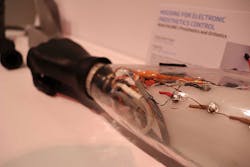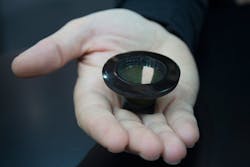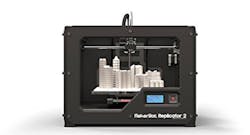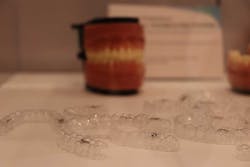Father of 3D Printing: Miracles Don't Come Fast or Easy
Because of 3D printing, someday we'll be able to grow new organs and body parts from biomaterials, erect custom-designed houses on-demand in a day and manufacture electronic devices with circuitry printed right inside. That's not hyperbole or hypothesis; this stuff is all being tested now and is closer to being real than you think.
With the speed at which things are moving, it won’t be long before superior machines such as HP's Multi Jet Fusion printers, which produce sturdy, usable parts at a rapid pace, will seem as archaic as a dot-matrix printer does to us.
It's hard to predict how far the industry can go, as the authority on such things, the Wohlers Associates, predicted in 2013 that the industry would be worth $10.8 billion in 2021. The 2019 Wohlers Report now predicts by 2022 that number to be $23.9 billion. It's safe to say the industry is exceeding everyone's expectations.
It's a bonkers industry right now, maybe even the one with the most potential to change the world. But what you may not know is that it had as humble a beginning as a world-changing invention can. And it was started by an equally humble man, Chuck Hull, a Geppetto-like figure who had no idea how magical his creation would be.
Carving an Industry
In the early 1980s, Hull kicked off the additive manufacturing movement with the advent of stereolithography (SLA), which uses a rapidly moving beam of UV light to cure specific parts of the liquid resin pool below, sculpting it from the bottom up as the build tray drops deeper into the pool.
At the time, Hull simply wanted to find a better way to prototype first articles for plastic injection molding. This manufacturing method is coveted for high volume, low-cost plastic parts, but getting to production was an exhaustive process. The iterative process required an engineer to design the part to be manufactured, but also a tool for the injection molding machine that would make the part.
"The problem back then was the designer would design a part and it was a long, long time before he actually ever had a part in his hand to judge whether or not it was what he wanted—and whether it was going to work for the intended use," Hull says.
That process could take six weeks, much too long for his liking, and he knew an alternative had to be out there, something he could commercialize and sell to other engineers. He was sure of it. The president of small California engineering company where Hull worked did not feel the same way.
"I was persistent," says Hull, who explained the president acquiesced to letting him pursue the hypothetical technology in the back lab on nights and weekends.
With the token workspace, along with a Hewlett Packard X-Y plotter, lamp output, resin, some fiber optics and meticulous programming skills, Hull made history. More specifically, he made an eyewash cup, but you get the point.
His wife "begrudgingly" drove down to the lab one night to see the finished product, which in hindsight is akin to seeing the first Gutenberg Bible hot off the printing press.
Hull went on to found 3D Systems to commercialize the tech. By the end of the '80s, the company's printers were making investment casting patterns for foundries.
"We could make these patterns at least in enough volume for foundries to do short run production," recalls Hull, 3D Systems' current CTO. These would become fixtures and tooling for factories.
It was enough to prove the technology had potential and other additive manufacturing methods were taking shape.
Adding to the Hype
Around the time Hull was working on industrializing 3D printing, Minnesotan Scott Crump was fiddling with plastic and glue guns in his kitchen to make a toy for his kid. That would be patented as Fused Deposition Modeling (FDM), the extrusion method trademarked by Crump's company Stratasys. Other companies, such as Ultimaker, call it Fused Filament Fabrication (FFF). Either way, a spool of plastic thread is fed into the extruder, where it is melted and dropped onto the build plate, layer-by-layer. This method is a common way for plants to directly make jigs and fixtures right on the factory floor to reduce downtime due to broken or inefficient tooling, no casting needed.
That's a really exciting use for plant managers who want to increase production and hit their KPI goals—and it's the reality of where additive manufacturing is most successful right now. For a deeper dive into how additive is transforming manufacturing, check out IndustryWeek's State of 3D Printing 2019.
But just existing in the real world was never going to be enough. By the beginning of this decade, people wanted more from the miracle technology. They weren't sure what to make of it, but they knew they wanted to be dazzled. And some even wanted to pull strings that weren't there.
Expectations for 3D printing were arguably higher in 2013 as they are now, because people had assumed using a 3D printer would be as easy as using a 2D printer sooner rather than later. One Wired headline from 2012 exclaimed: "The New MakerBot Replicator Might Just Change Your World."
The thought was that the tech would transfer to the consumer world just as personal computers did. Every home would become a miniature manufacturing plant, able to whip up appliance repair parts or figurines for the kids. Why, even dinner could be 3D-printed.
"Soon, probably in the next few years, the market will be ready for a mainstream 3-D printer sold by the millions at Walmart and Costco," Wired's Chris Anderson wrote.
But you can’t blame people for being excited. You can point to the investors for failing to understand the tech, or that people are inherently lazy.
Due to the hype, 3D Systems saw a huge swell of investor confidence as startups flooded the field promising home 3D printers trying to capitalize on the excitement pushed by executives and the media. They even launched a consumer printer called the Cube. And a fancy culinary lab in Los Angeles.
Things were spiraling out of control, as is oft the case with new tech, and people were too busy either buying in or selling absurdist fantasies to question the efficacy of it all. Makerbot's CEO Bre Pettis was quoted in the Wired story comparing the Makerbot Replicator to "Darth Vader driving Knight Rider's KITT car while being airlifted by a Nighthawk spy plane."
Looking back, the problem may have been that everyone was so excited by the finished product that they didn’t consider how difficult it is for an average person to make a 3D rendering of an object, "slice" it into digital layers so the machine knows how to approach the print job, and take into effect environmental factors, maintenance, and if it's even worth it.
Here's a quick analogy: Yes, you can grow your own tomatoes, and they would be delicious, but that takes time, space, the right weather, protection from critters, etc. It's much simpler to grab a bag as you're passing by the supermarket produce aisle. And if you must have heirloom tomatoes, you can provide a local farmer with the seeds and they do the rest. You can see this with contract manufacturers popping up everywhere. Even the UPS Store has 30 U.S. sites for custom 3D printing jobs.
When people realized how much more difficult it is to run a machine than talk about it, investor backlash, the whale of this tale, took a huge bite out of 3D printing confidence. 3D Systems had a stock drop of 55% in 2014, and about 92% overall until charging back in 2016 with a nearly 53% increase. The Cube was end-of-lifed at the conclusion of 2015.
In this respect, if you're more into tragic Greek myths than saccharine Disney parables, Hull is probably maybe more like Daedalus, the father of Icarus, an inventor who crafted those wax wings for his son to take flight, but to mind his altitude.
Hull, forever grounded in reality and not much for metaphors or myths, attributes the fall to pure human hubris and failure to do the work.
"I've never looked at it philosophically, but there was a period where there was obviously a lot of hype and people started hearing about 3D printing and imagining it can do all these things," Hull says. "And maybe it can do everything. [But] then you had the people jumping in to tackle the impossible —small companies and investors and entrepreneurs—running across the reality."
He considers that trough of disillusionment, and all the hyperbole, as part of the process.
"The good thing about that period is that nobody knew what 3D printing was and we'd always have to try to explain why they should care," Hull says. "Nowadays it's pretty well understood."
He says that understanding includes some disillusionment, but at the same time has revealed the truth of 3D printing—and its actual potential.
For now that potential is in repeatable industrial applications, as well as perfecting a wider selection of materials and printing techniques, specifically direct metal laser sintering and multi jet. 3D Systems now has both in its portfolio and has expanded its partnerships with traditional manufacturers, such as GF Machining Solutions.
The original method is still the company's most successful use case, and the highest volume in all the industry. A proprietary Align Technologies application produces more than 350,000 dental aligners per day. The aligners are thermoformed over 3D-printed molds, not 3D-printed themselves.
Disposable orthodontia is quite the revolution, especially for parents who have had to dumpster dive for their kids' retainers. But what about disposable organs, for those who have treated their bodies like trash or just have garbage luck?
SLA may hold the answer here as well. Newsweek recently reported on a team of researchers working to 3D-print living tissue, and eventually organs.
Stuff like this Hull can’t possibly be modest about. This is the next closest thing to creating life from nothing. Hull says he works "quite a bit" in that particular science-fiction domain and is familiar with its advances, but again brings expectations crashing back to earth.
"I'm also familiar with how much work it is to go from this concept to making them happen," Hull says. "So there's lots of research, lots of effort to be done still before a lot of these miraculous things happen."
Even miracles, it appears, take planning and time.
For now, maybe it's best not to get sucked in by hyperbole or look too far in the future. Like Hull, just try to find what one application can be made a little better, a little faster. Then put in the time and you'll have something real, if not world-changing.
About the Author
John Hitch
Senior Editor
John Hitch writes about the latest manufacturing trends and emerging technologies, including but not limited to: Robotics, the Industrial Internet of Things, 3D Printing, and Artificial Intelligence. He is a veteran of the United States Navy and former magazine freelancer based in Cleveland, Ohio.
Questions or comments may be directed to: [email protected]






